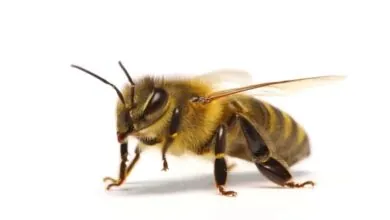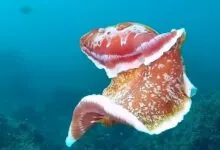House Finch Eggs: A Guide to Identification, Incubation and Hatchlings
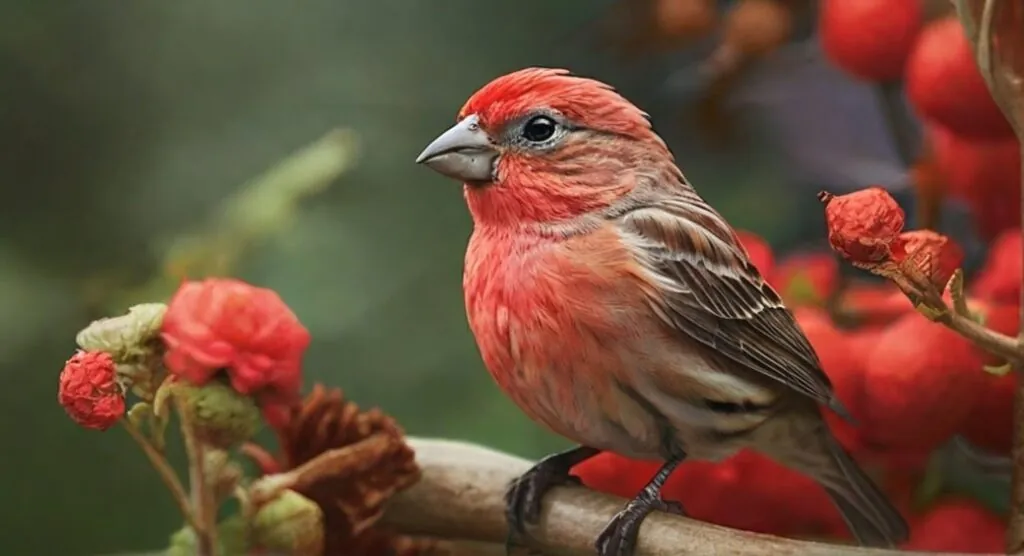
Ever come across by chance a hidden nest, filled with tiny, speckled treasures? As a bird enthusiast, I’m perpetually captivated by the wonders of the natural world and the house finch is no exception. This familiar sight in backyards and gardens boasts a vibrant song and an enthralling story. Have you ever gotten a glimpse of the delicate marvels that mark the beginning of this story – house finch eggs?
Let’s embark on a journey together, discovering not only the secrets of house finch eggs but also the captivating habits and lifestyle. Without further ado, let’s get started.
| Kingdom | Phylum | Class | Order | Genus | Family | Scientific Name |
| Animalia | Chordata | Aves | Passeriformes | Haemorhous | Fringillidae | Haemorhous mexicanus |
House Finch Eggs
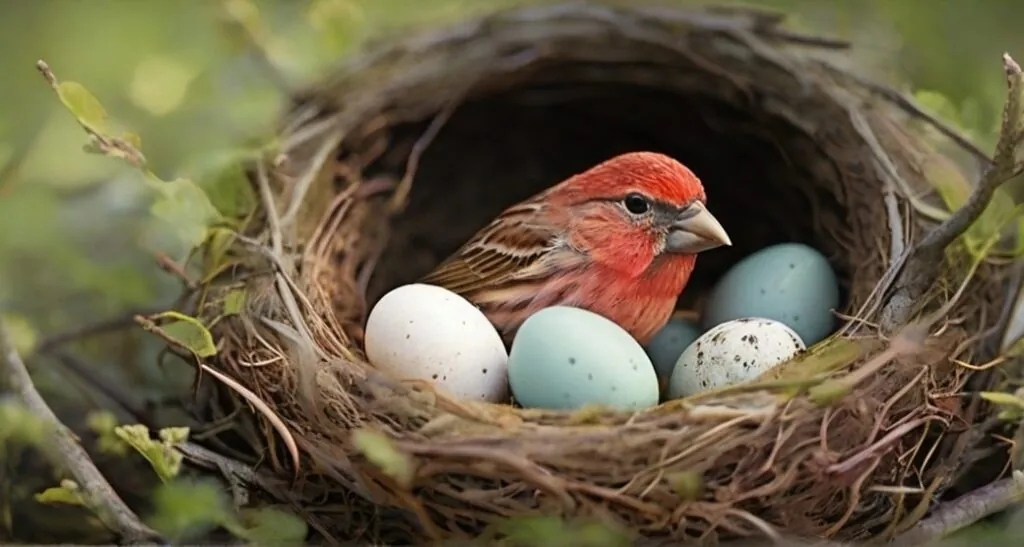
The house finch, scientifically known as Haemorhous mexicanus, is a common songbird found in North America. What makes them more conspicuous is its vibrant red plumage in males and streaky brown feathers in females.
They’re cavity nesters, building their nests in a plethora of locations like trees, shrubs and even human-made structures like birdhouses. These songbirds are prolific breeders that raise 2 to 3 broods per year with each clutch containing 4 to 5 eggs on average.
Importance of Understanding
Studying house finch eggs offer valuable insights into the breeding biology of the species. Comprehending their egg size, clutch size, incubation period and hatching success can assist to monitor population health and identify potential threats.
Spotlighting the markings on house finch eggs can also unpack information about their nesting success potential adaptations to environmental factors.
House Finch Eggs
Shape: Their eggs are oval-shaped, with one end slightly larger than the other.
Color: House finch eggs feature a striking color variation, ranging from pale blue to white.
Size: These tiny marvels are amazingly small that measure only 0.6 to 0.8 inches (1.5-2.0 cm) long and 0.5-0.6 inches (1.3-1.5 cm) wide.
Patterns: House finch eggs are garlanded with fine black and purple speckles, concentrated chiefly on the larger end of the egg. This speckling pattern can vary in density and distribution betwixt individual eggs, even within the same clutch.
Egg Formation and Laying
Female Reproductive Cycle
Similar to other birds, house finch egg formation is triggered by hormonal changes within the female. Egg development kicks off with a single cell in the ovary, which extends and accumulates yolk over several days.
As the egg travels down the oviduct, the albumen (egg white) and shell membrane are added. If fertilization occurs, the egg receives a sperm cell and continues its journey down the oviduct, where the calcium-rich shell is deposited. The entire process from egg formation to laying generally takes 4 to 5 days.
Nesting Behavior
When it comes to the house finch’s nesting behavior, the female house finch takes the chief responsibility for constructing the nest. She uses twigs, grasses, leaves and other soft materials to construct a cup-shaped nest in sheltered location. The moment nest is complete, the female starts laying eggs. For more information about House Finches, their behavior, and how to attract them to your backyard, you can visit the Cornell Lab of Ornithology.
Timing of Egg Laying
House finch’s breeding season typically lasts from March to August in North America. Females normally lay one egg per day until the clutch is complete. The entire house finch eggs laying process for a single clutch can take 4 to 7 days.
Number of Eggs per Clutch
Being prolific breeders, house finches lay 2 to 3 broods per season. Each clutch generally contains 4 to 5 eggs, albeit some clutches can range from 3 to 8 eggs. Compellingly, research unfolds that females may strategically lay eggs containing females first, particularly when mite infestations are present.
Incubation Period
Incubation Process
The moment clutch is complete, the female house finch begins the incubation process. It encompasses sitting on the eggs continuously to maintain an ideal temperature of around 104°F (39.4°C) and promote development. Meanwhile, the female may briefly leave the nest to feed and preen.
Parental Roles in Incubation
Predominantly, the female is responsible for incubation in house finches. The male house finch may once in a blue moon take short incubation stints, but this behavior is less common.
Factors Influencing Incubation Duration
The incubation period for house finch eggs normally lasts 12 to 14 days. Nonetheless, this duration can be molded by several factors, including ambient temperature, clutch size and individual variation.
Significance of Egg Characteristics
The unparalleled characteristics of house finch eggs, like their size, color and markings, are thought to be adaptive features that have evolved to stretch their reproductive success.
The small size of house finch eggs makes them less vulnerable to predators, as they entail less energy for the female to incubate. The pale blue or white color with fine speckles is believed to be a form of camouflage. The speckles might help the eggs blend in with the surrounding nest material.
House Finch Scientific Name
Over and above house finch’s majestic appearance lies a unique scientific name – Haemorhous mexicanus. “Haemorhous” comes from the ancient Greed words “Haima” implying blood and “orhos” meaning boundary. It’s a referent o the red plumage found in many species within the genus. The next part, “mexicanus,” signifies the origin of the house finch. The very term is the Latin word for Mexican, indicating that the species was first described from specimens collected in Mexico.
Though “mexicanus” proposes a Mexican origin, the house finch is not actually native to North America. It was accidentally introduced from the eastern Mediterranean region in the early 20th century.
The scientific name “Haemorhous mexicanus” was first assigned to the house finch in 1823 by the French naturalist René Primevère Lesson. Since then, the name has remained unchanged, serving as a permanent identifier.
Origin and Evolution
Evolutionary History
The house finch’s ancestors can traced back to a group of finches called the Carduelinae which originated in Eurasia millions of years ago. Around 2 to 3 million years back, a lineage within the Cardeulinae branched off and migrated across the Bering Land Bridge. It resultantly gave rise to the North American rose finches, including the house finch.
Concerning the house finch evolution, a key event occurred around 10,000 years ago when the Wisconsin glaciation reshaped the North American landscape. The very event is believed to have fragmented the ancestral house finch population. Consequently, it led to the isolation and differentiation of two species:
Environmental Adaptations
The house finch’s adaptations are remarkable to diverse environments. At the outset a bird of hot deserts and dry open habitats, it has successfully colonized a stretched range of habitats across North America, including forests, grasslands, urban areas and coastal regions.
Distribution and Population
Geographic Range
The house finch’s distribution they’re enjoying today stretched across North America, spanning from southern Canada southward through Mexico and reaching as far south as Guatemala. In the annals of time, their range was confined to the eastern Mediterranean region, including parts of Turkey, Syria and Israel.
In early 20th century, the house finch was serendipitously introduced to North America, most probably through the pet trade. From that juncture, it’s undergone an expansion across the continent.
Population Dynamics
In conjunction with the house finch population, some reports suggest a total population potentially between 257 million and 1.7 billion. Though the species is encountering some threats like habitat loss and disease outbreaks, its population appears to be relatively stable overall.
Geography
| Continents | North America, South America (introduced) |
| Countries | Canada, United States, Mexico, Guatemala (introduced) |
| Bio-geographical Realms | Nearctic |
| Biome | Temperate grassland, Mediterranean scrubland, urban/suburban habitats |
| Climate Zones | Temperate, subtropical, arid |
Habitat

The captivating house finch eggs may steal the spotlight, but their habitat holds equally fascinating secrets.
Habitat Preferences
The house finch’s habitat encompasses a plenty of ecosystems across North America, including forests, grasslands, urban areas and coastal regions. In addition, house finches oftentimes prefer specific microhabitats that provide proximity to food sources, nesting sites and protection from predators.
Habitat Utilization Patterns
House finches are typically regarded as non-migratory in most of their North American range. They may showcase short-distance movements in response to food accessibility or weather conditions. But, generally they remain within their established territories year-round.
These songbirds are diurnal creatures, implying they’re most active during the day. Their daily routine involves foraging, singing, nesting and preening.
5 House Finch Facts
Appearance
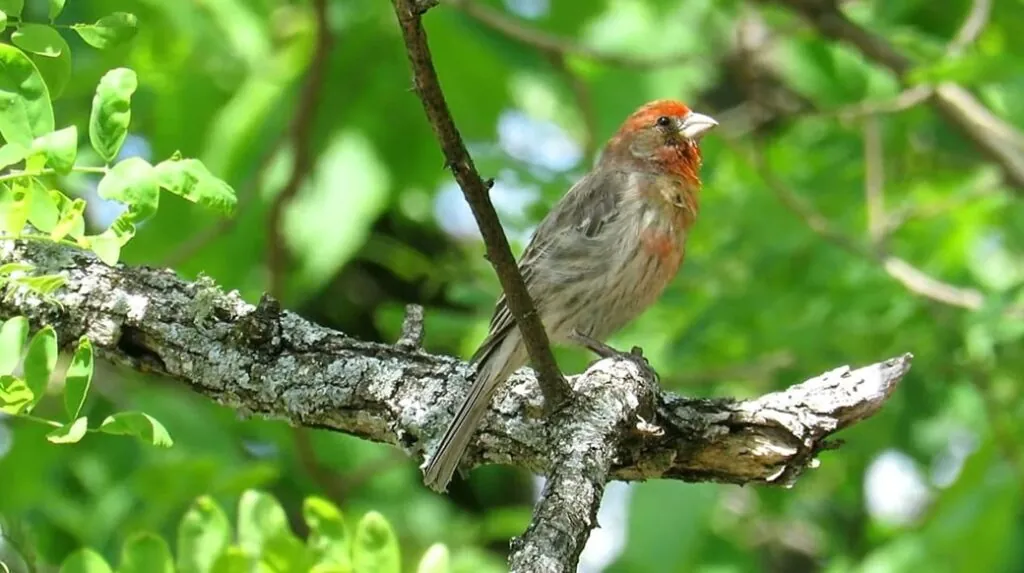
Above and beyond the enchanting the house finch eggs, the secrets of their appearance beckon further exploration.
Physical Characteristics
Size: House finch’s size is relatively small, measuring 5.1-5.5 inches (13-14 cm) in length. Their wingspan measures 7.9- 9.8 inches (20-25 cm).
Shape: They sport a compact, rounded body with a short, conical beak. The house finches’ tail is short and slightly notched and their legs and feet are strong. On a related note, got the scoop of zebra finch?
Color: Males boast red plumage which covers the head, neck, breast and upper back. Females, on the flip side, are embellished with streaky brown feathers across their back, wings and tail.
Markings: On their folded wings, both males and females have two distinct white wing bars. Additionally, males may feature some brown streaking on their flanks.
Distinctive Features: What makes house finch more prominent is its relatively large bill compared to tis body size. Besides, their usually sing melodic song, which male use to attract mates and defend their territories.
House finches, captivating examples of successful adaptation according to the Audubon Society, are common visitors to backyard feeders.
Sexual Dimorphism
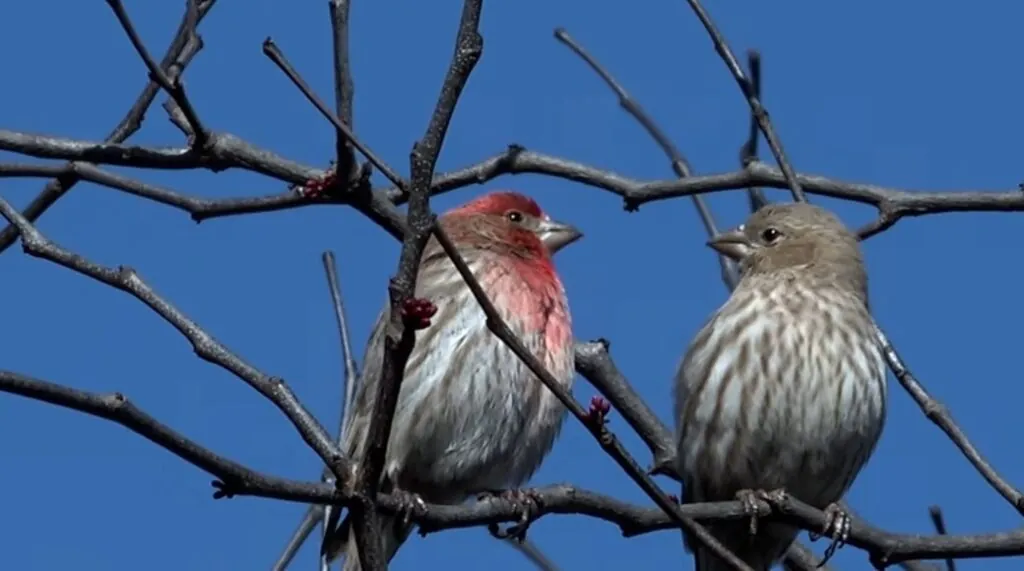
Males and females have significant differences in their appearance. This difference, chiefly in plumage coloration, is a common strategy among birds. Males often display brighter colors to attract mates and females showcasing camouflage patterns for nesting and predator avoidance.
House Finch Anatomy
| Color(s) | Male: Red head and breast, brown back and wings, streaked underparts. Female: Brown overall with faint streaking |
| Tongue | Short, fleshy, and adapted for seed consumption |
| Claws | Sharp and curved, used for perching and grasping |
| Mouth | Small and pointed, with a hard beak for cracking seeds |
| Jaw | Strong and muscular, capable of exerting significant force |
| Teeth | Absent, replaced by a hard, keratinized beak |
| Nostrils | located at the base of the beak, used for breathing and scent detection |
| Feet | Perching feet with four toes (three forward, one backward) for grasping branches |
| Skeleton | Lightweight and adapted for flight, with hollow bones and a keeled sternum |
Reproduction and Life Cycles
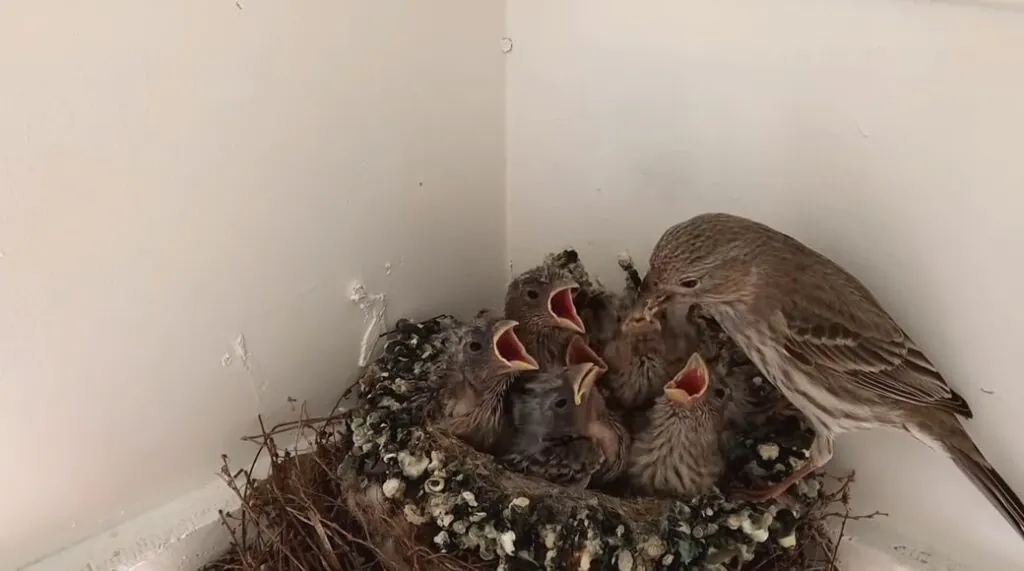
Even as house finch eggs capture our fascination, their reproduction and life cycles are brimming with equally intriguing tales yet to be told.
Mating System
The social behavior of house finch falls under monogamy. It implies that they generally form pairs during the breeding season and work together to raise their young.
Over the span of breeding season, males attracts potential mates employing an array of strategies, including vibrant plumage, melodious songs and courtship displays. Females, on the other hand, carefully evaluate potential mates built upon a plethora of factors, including plumage coloration, song complexity and territory quality.
Life Cycle Stages
House finches can reach an average lifespan of 3-5 years in the wild and 11 years and 7 months in captivity.
Mating Habits
| Mating Behavior Monogamous | |
| Reproduction Season March to August, with multiple clutches possible per year | |
| Litter Size 3-6 eggs, typically 4-5 | |
| Incubation Period 12-14 days, primarily by the female. | |
| Independent Age 12-15 days after hatching, but parents continue to feed them for some time |
Diet and Lifestyle
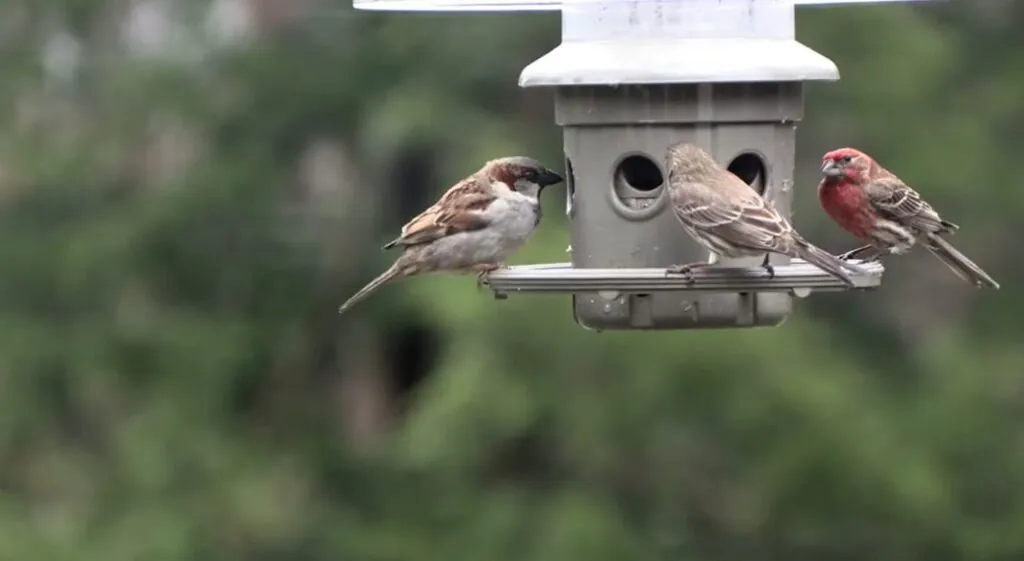
While house finch eggs capture headlines, their diet and lifestyle hold a trove of captivating narratives waiting to be explored.
Feeding Ecology
With respect to the house finch’s diet, they’re granivorous birds, that is, their diet is primarily comprises seeds. Nevertheless, they exhibit remarkable dietary flexibility. Their primary food sources include seeds from different plants, including dandelions, sunflowers, thistles, and weeds and fruits like berries and figs.
They may supplement their diet with insects like aphids, caterpillars and beetles particularly during the breeding season.
Foraging Strategies
These tiny creatures are ground foragers and spend a signifying portion of their day hopping on the ground, perching on branches and gleaning seeds and insects from various sources. The key strategies deployed by house finches during foraging include visual cues, bill manipulation and social learning.
Threats and Conservation
Conservation Status
As per the IUCN Red List, the house finch conservation status is typified as “Least Concern.” The factors that are influencing their conservation status include adaptability, widespread distribution and high reproductive rate.
Primary Threats
Albeit their non-alarming conservation status, there’re still threats to be aware of, including disease outbreaks such as house finch eye disease (conjunctivitis), habitat loss and degradation and competition with introduced species.
Relationship with Humans
Cultural Significance and Symbolism
In the United States, the house finch has come to symbolize resilience thanks to its widespread presence and adaptability. Its plumage and striking song have inspired various artists and writers.
Media and Entertainment
In the realm of art, these species have made their conspicuous presence in multiple genres:
Unique Characteristics
Forge a path through an intriguing journey as we unfold fascinating facts about house finches – truly captivating animals that start with H. Join us in shedding light on their remarkable rundown!
| Common Name | House Finch |
| Other Name(s) | Linnet |
| Number of Species | 1 (Haemorhous mexicanus) |
| Population Size | Estimated 1.5 billion individuals |
| Lifespan | 3-5 years (in the wild); 11 years and 7 months (Maximum recorded in captivity) |
| Weight | 11-20 grams (0.39-0.71 oz) |
| Length | 12-14 cm (4.7-5.5 in) |
| Wingspan | 21-24 cm (8.3-9.4 in) |
| Top Speed | 35-40 mph (56-64 kph) |
| Predators | Hawks, owls, snakes, cats |
| Prey | Seeds, insects, fruits |
| Most Distinctive Feature | Male: Bright red head and breast. Female: Streaked brown plumage |
FAQs


